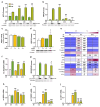NRF2 and Thioredoxin Reductase 1 as Modulators of Interactions between Zinc and Selenium
- PMID: 39456464
- PMCID: PMC11505002
- DOI: 10.3390/antiox13101211
NRF2 and Thioredoxin Reductase 1 as Modulators of Interactions between Zinc and Selenium
Abstract
Background: Selenium and zinc are essential trace elements known to regulate cellular processes including redox homeostasis. During inflammation, circulating selenium and zinc concentrations are reduced in parallel, but underlying mechanisms are unknown. Accordingly, we modulated the zinc and selenium supply of HepG2 cells to study their relationship.
Methods: HepG2 cells were supplied with selenite in combination with a short- or long-term zinc treatment to investigate intracellular concentrations of selenium and zinc together with biomarkers describing their status. In addition, the activation of the redox-sensitive transcription factor NRF2 was analyzed.
Results: Zinc not only increased the nuclear translocation of NRF2 after 2 to 6 h but also enhanced the intracellular selenium content after 72 h, when the cells were exposed to both trace elements. In parallel, the activity and expression of the selenoprotein thioredoxin reductase 1 (TXNRD1) increased, while the gene expression of other selenoproteins remained unaffected or was even downregulated. The zinc effects on the selenium concentration and TXNRD activity were reduced in cells with stable NRF2 knockdown in comparison to control cells.
Conclusions: This indicates a functional role of NRF2 in mediating the zinc/selenium crosstalk and provides an explanation for the observed unidirectional behavior of selenium and zinc.
Keywords: NRF2; selenium; selenium transporter; thioredoxin reductase; zinc.
Conflict of interest statement
The authors declare no conflicts of interest.
Figures





Similar articles
-
Cellular activity of the cytosolic selenoprotein thioredoxin reductase 1 (TXNRD1) is modulated by copper and zinc levels in the cell culture medium.J Trace Elem Med Biol. 2025 Apr;88:127624. doi: 10.1016/j.jtemb.2025.127624. Epub 2025 Feb 17. J Trace Elem Med Biol. 2025. PMID: 39983285
-
Copper interferes with selenoprotein synthesis and activity.Redox Biol. 2020 Oct;37:101746. doi: 10.1016/j.redox.2020.101746. Epub 2020 Oct 7. Redox Biol. 2020. PMID: 33059313 Free PMC article.
-
Crosstalk of Nrf2 with the Trace Elements Selenium, Iron, Zinc, and Copper.Nutrients. 2019 Sep 5;11(9):2112. doi: 10.3390/nu11092112. Nutrients. 2019. PMID: 31491970 Free PMC article.
-
Redox regulation of protein kinase C by selenometabolites and selenoprotein thioredoxin reductase limits cancer prevention by selenium.Free Radic Biol Med. 2018 Nov 1;127:55-61. doi: 10.1016/j.freeradbiomed.2018.05.062. Epub 2018 May 22. Free Radic Biol Med. 2018. PMID: 29775743 Review.
-
Selenium metabolism, selenoproteins and mechanisms of cancer prevention: complexities with thioredoxin reductase.Carcinogenesis. 1999 Sep;20(9):1657-66. doi: 10.1093/carcin/20.9.1657. Carcinogenesis. 1999. PMID: 10469608 Review.
References
-
- Peters K.M., Galinn S.E., Tsuji P.A. Selenium: Dietary Sources, Human Nutritional Requirements and Intake across Populations. In: Hatfield D., Schweizer U., Tsuji P., Gladyshev V., editors. Selenium: Its Molecular Biology and Role in Human Health. Springer International Publishing; Cham, Switzerland: 2016. pp. 295–305.
Grants and funding
LinkOut - more resources
Full Text Sources

